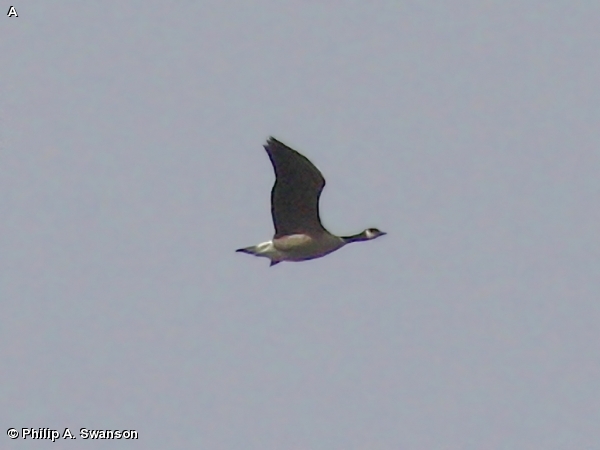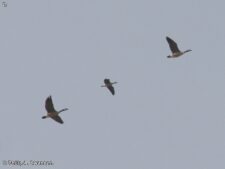
27 inches long with a wingspan of 47 inches. Sexes are alike with the male generally being larger. Closer to the size of a large duck, the Cackling Goose looks like a small version of a Canada Goose . The head and neck are black with a broad white throat patch that extends up to the cheek. The base of neck, upper back, and breast are rather variable, generally medium gray-brown to dark brown. The breast and belly are brownish-white. The rump and central upper tail-coverts are black. The belly, vent, and undertail coverts are white with a black tail. The black bill of the Cackling Goose is stubby and short. The bill length is about 50% of the depth of the head while the bill length on small types of Canada Geese is about 70% of the depth of the head. The Cackling Goose has a somewhat blocky head with a flat top and a steep forehead. Canada Geese have a more wedge-shaped head that tends to blend into the angle of the upper bill.
The Cackling Goose is a somewhat common spring and fall migrant in the Forest. It is best seen from the Great Marsh and along Stream Trail while flying overhead. The best times are March and April and again in October and November. Some may overwinter close to the area. Cackling Geese are generally seen in flocks of Canada Geese.
The Cackling Goose has recently been split from the Canada Goose. There are several subspecies of Canada Geese. Cackling Geese are comprised of what were the smallest four subspecies. The Cackling Goose subspecies most likely to be seen in our area is the Richardson’s (or Hutchins’s) form. This form generally winters along the Texas coast and breeds on the Arctic tundra. The call of Cackling Geese is higher pitched than that of Canada Geese. It is sometimes referred to as a cackling sound.
Disclaimer: The content of NatureSearch is provided by dedicated volunteer Naturalists of Fontenelle Forest who strive to provide the most accurate information available. Contributors of the images retain their copyrights. The point of contact for this page is: Phil Swanson.


